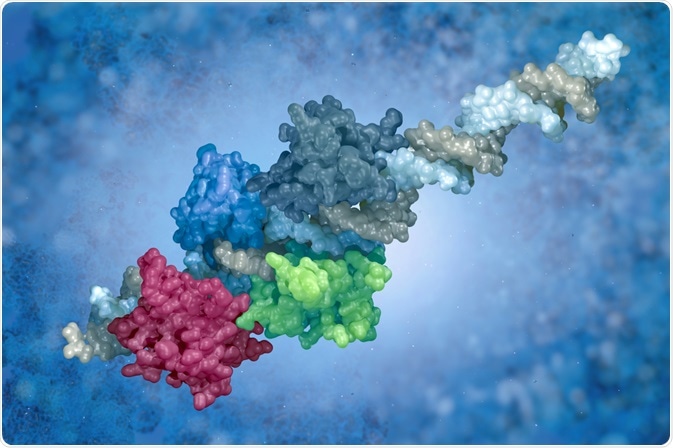Cell surface proteomics is the study of cell surface proteins, which can be essential in understanding protein structure, function, modifications they undergo, and more.
This information can be crucial in identifying potential biomarkers of disease, such as cancer, and can be influential in the establishment of innovative therapies.

Image Credit: vitstudio/Shutterstock.com
What is the study of cell surface proteomics and why is it important?
Proteomics is the extensive study of the proteome, which refers to the complete set of proteins that are expressed by an organism. Proteins are complex molecules built by amino acids that govern many essential processes inside the human body.
They are implicated in crucial functions such as maintaining the regulation, structure, and operations of the body’s organs and tissues.
They also control biochemical reactions, act as hormones, provide structure in the form of collagen, maintain the correct pH, balance fluids, form immunoglobulins to fight infection, transport and store nutrients, and provides energy.
The majority of the work they do occurs within the cells, and due to this, studies encompassing many fields of science have investigated their behavior within the cells to develop a number of applications.
The organism’s genome is reflected in the expression of the proteome, but the two are different. While a genome is stable, the proteome can respond dynamically to factors such as developmental stages, as well as internal and external environments.
The study of proteomics reveals how proteins work and how they interact. Research is able to reveal their structure, how they perform their functions, what modifications they undergo and much more. The outcome of proteomics has already generated much invaluable data. For example, it has enabled the identification of an increasing number of proteins.
Specifically, the area of proteomics, which looks into cell surface proteins, has been vastly profitable in terms of the knowledge gained and the identification of potential critical applications.
Cell surface proteins are a particular family of proteins, the functions of which include managing vital cellular functions and communicating between the cell and environment through transporting metabolites, ions, and other solutes across the plasma membrane.
The importance of these proteins becomes even more apparent when the fact that a significant proportion, 25–30%, of human genes encode for cell membrane proteins is considered.
Cancer research is one major area that is benefiting greatly from cell-surface proteomics studies. Investigations have already resulted in the discovery of numerous potential biomarkers for neuroblastoma, as well as highlighting potential avenues for new therapies for various cancers.
Applications of cell surface proteomics
Cell surfaces present a crucial biomarker and potential drug target for various illnesses due to the vital role they play in governing interactions between cells, transporting metabolites and proteins, and translating extracellular signals into intracellular responses.
In fact, around 70% of modern pharmaceuticals have been developed to target cell surface proteins. For this reason, proteomic profiling of cell surface proteins has become increasingly popular and conducive to the discovery of new biomarkers and drug targets.
As well as this, proteomics has been effective in being used in structural proteomics, the study of proteomic interaction and protein networks, expression proteomics, and proteogenomics.
However, major barriers remain that need to be overcome in the field of cell surface proteomics. Firstly, cell surface proteins have poor solubility in pure aqueous buffers, they have a high degree of heterogeneous posttranslational modifications, and they present a wide expression level.
These factors make cell surface proteins a challenge to prepare and analyze. Scientists are currently working on overcoming these restrictions by improving the process of enriching the cell surface proteins before analysis.
Techniques of studying cell surface proteomics
There are multiple techniques that are appropriate and efficient at studying proteomics. These methods usually fall into one of two categories. The first being techniques that detect proteins using antibodies, known as immunoassays.
The second family of methods involves using mass spectrometry, which measures the mass-to-charge ratio of ions. In the case that analysis of a particularly complex biological sample is required, then a specific antibody is used in a quantitative dot blot analysis in preparation for the detection step of the method. This reduces the number of molecules to analyze within a sample, increasing the technique's accuracy.
Identification of novel therapeutic targets in cancer
Identifying new potential targets for cancer treatment as well as establishing biomarkers for various cancer types has been the main focus of cell surface proteomics in recent years. They have an easily accessible position, and they are often implicated in the maladaptive regulation of crucial signaling pathways in cancer.
Summary
Cell surface proteomics holds a great deal of untapped potential for the development and prevention of various diseases through the identification of disease biomarkers and targets for therapy.
Currently, research into cell-surface proteomics is very active and is uncovering much knowledge surrounding how these proteins function, interact with one another, and influence disease, particularly cancer. The coming years are likely to see continued acceleration in work in this field.
Sources:
- Caceres, P., Gravotta, D., Zager, P., Dephoure, N. and Rodriguez-Boulan, E. (2019). Quantitative proteomics of MDCK cells identify unrecognized roles of clathrin adaptor AP-1 in polarized distribution of surface proteins. Proceedings of the National Academy of Sciences, p.201821076. https://www.pnas.org/content/116/24/11796
- Kuhlmann, L., Cummins, E., Samudio, I. and Kislinger, T. (2018). Cell-surface proteomics for the identification of novel therapeutic targets in cancer. Expert Review of Proteomics, 15(3), pp.259-275. https://www.ncbi.nlm.nih.gov/pubmed/29343144
- Ye, X., Kaczmarczyk, J., Luke, B., Saul, R., Whiteley, G., Nissley, D. and Blonder, J. (2019). Cell surface protein enrichment for biomarker and drug target discovery using mass spectrometry-based proteomics. Proteomic and Metabolomic Approaches to Biomarker Discovery, pp.409-420. https://www.sciencedirect.com/science/article/pii/B9780128186077000244
Further Reading